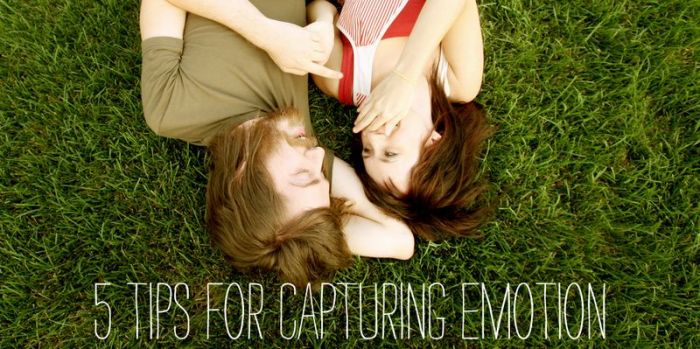
5 Tips for Capturing Emotion in Photos: Have you ever looked at a photograph and felt a surge of emotion? Whether it’s joy, sadness, or anything in between, a powerful image can transport us to another place and time, evoking a range of feelings.
This is the magic of photography, the ability to capture not just a moment but the essence of a feeling. But how do we achieve this? How do we translate emotions into tangible, visual elements that resonate with the viewer?
Let’s explore five key tips to help you capture the heart and soul of your subjects, creating images that move and inspire.
From understanding the nuances of facial expressions to harnessing the power of light and composition, we’ll delve into the art of capturing emotion in photography. This isn’t just about technical skills; it’s about developing an emotional connection with your subjects and understanding how to convey that connection through your images.
Understanding Emotion in Photography
Photography is more than just capturing moments; it’s about telling stories. And stories are most impactful when they evoke emotions in the viewer. Whether it’s joy, sadness, awe, or even anger, a photograph that connects with your audience on an emotional level will leave a lasting impression.
The Role of Emotion in Visual Storytelling
Emotions are the driving force behind our engagement with stories. They create a sense of connection and empathy, allowing us to experience the world through the lens of the photographer’s perspective. When a photograph successfully evokes an emotion, it transcends the purely visual and becomes a powerful form of communication.
Examples of Emotionally Evocative Photographs
- “The Migrant Mother” by Dorothea Lange:This iconic photograph captures the desperation and hardship faced by a migrant mother during the Great Depression. The woman’s weary gaze and the children huddled around her convey a sense of profound sadness and vulnerability. The use of natural light and the simple composition create a sense of intimacy and realism.
Sometimes, the best way to capture emotion in photos is to think outside the box. Instead of focusing on a person’s face, try capturing their hands, their posture, or even the objects around them. For example, if you’re photographing someone who loves crafting, you could include a project they’re working on, like a upcycle a lip balm into an ornament.
These details can add a layer of depth and meaning to your photos, telling a story without saying a word.
- “Afghan Girl” by Steve McCurry:This photograph of a young Afghan girl with piercing green eyes has become a symbol of the human cost of war and conflict. The girl’s gaze, full of intensity and sadness, evokes a sense of empathy and concern for her plight.
The photograph’s composition, with the girl’s face filling the frame, draws the viewer’s attention to her emotions.
- “The Falling Man” by Richard Drew:This photograph, taken on September 11, 2001, captures the horrifying moment when a man jumped from the World Trade Center towers. The image is a powerful reminder of the human cost of tragedy and evokes feelings of shock, horror, and grief.
The photograph’s starkness and the man’s helpless pose create a sense of immediacy and visceral impact.
Considering the Viewer’s Emotional Response
Understanding how viewers perceive and react to emotions is crucial for photographers. Different cultures and individuals may interpret emotions differently, so it’s important to be mindful of the context in which your photographs are viewed.
Capturing Facial Expressions

Facial expressions are powerful tools for conveying emotions in photographs. By understanding how different emotions manifest in the face, photographers can capture authentic and impactful moments.
Identifying Key Facial Features
The human face is a complex canvas of emotions, with subtle nuances expressed through various features. By focusing on specific areas, photographers can effectively capture the essence of an emotion.
- Eyes:The eyes are often referred to as the “windows to the soul,” and they play a crucial role in expressing emotions. Dilated pupils, raised eyebrows, and narrowed eyes can all convey different feelings. For instance, widened eyes can suggest surprise or fear, while narrowed eyes might indicate anger or suspicion.
- Mouth:The mouth is another key feature that reveals emotions. A wide smile suggests happiness, while a pursed lip might indicate sadness or frustration. A clenched jaw can convey tension or anger.
- Forehead:The forehead can also be expressive, with wrinkles forming during moments of worry or concentration. Raised eyebrows often accompany surprise or disbelief, while furrowed brows can indicate anger or sadness.
- Cheeks:Cheeks can blush with embarrassment or excitement, and their position can affect the overall expression. A raised cheek can suggest a smile, while a drooping cheek might indicate sadness or fatigue.
Capturing Subtle and Exaggerated Expressions
Photographers have the ability to capture a wide range of expressions, from subtle nuances to exaggerated displays.
- Subtle Expressions:Subtle expressions can be captured by focusing on small details, such as a slight twitch of the lips or a flicker of emotion in the eyes. These expressions are often more authentic and genuine, as they reflect the subject’s true feelings.
To capture these nuances, photographers should use a wide aperture to blur the background and draw attention to the subject’s face. They should also use a fast shutter speed to freeze the moment and avoid blurring.
- Exaggerated Expressions:Exaggerated expressions can be used to create dramatic and impactful photographs. These expressions are often more obvious and easily recognizable, but they can also be more theatrical and staged. To capture exaggerated expressions, photographers should work with their subjects to create a specific mood or feeling.
From genuine smiles to tearful embraces, capturing emotion in photos is all about connecting with your subject. A little bit of anticipation can go a long way, so think about the story you want to tell. And don’t forget to brighten up your spring with Prezzybox’s fresh gift selection – a little joy can make a big difference in your photos.
Remember, the best photos are often those that tell a story, so let your subjects express themselves freely and authentically.
They may use props, lighting, or other techniques to enhance the expression.
Examples of Facial Expressions and Emotions
The following table provides examples of different emotions and their corresponding facial expressions:
| Emotion | Facial Expressions |
|---|---|
| Happiness | Wide smile, raised cheeks, crinkled eyes, relaxed brow |
| Sadness | Drooping mouth, furrowed brows, downcast eyes, slight frown |
| Anger | Clenched jaw, narrowed eyes, furrowed brows, raised voice |
| Fear | Wide eyes, raised eyebrows, open mouth, rapid breathing |
| Surprise | Wide eyes, raised eyebrows, open mouth, slightly tilted head |
| Disgust | Wrinkled nose, raised upper lip, narrowed eyes, pursed lips |
Using Body Language

Body language is a powerful tool for conveying emotion in photography. It can tell a story, reveal a person’s inner state, and even add depth to a portrait. Think about the subtle cues our bodies give off—a clenched fist, a slumped posture, or a wide smile.
You know how important it is to capture emotion in photos, right? It’s all about finding those genuine moments and making your viewers feel something. For a little inspiration, check out the Tory Burch summer capsule collection , which embodies a carefree spirit and summer joy.
The vibrant colors and playful prints are a great reminder that even a simple photograph can convey a strong emotion. So, keep experimenting with your angles, lighting, and composition to capture the magic of those fleeting moments.
These nonverbal signals can speak volumes about how someone feels.
Examples of Body Language in Photography
Photographers often use body language to enhance the emotional impact of their images. For example, a photo of a lone figure standing on a cliff with their arms outstretched might convey a sense of freedom and liberation. Alternatively, a photo of someone hunched over with their head in their hands could evoke feelings of sadness or despair.
- A photo of a dancer in mid-aircould convey a sense of joy, freedom, and grace. The dancer’s extended limbs and upward gaze suggest a feeling of exhilaration.
- A photo of a couple holding handscould convey a sense of love, connection, and intimacy. The physical closeness and the intertwined fingers suggest a deep bond between the two individuals.
- A photo of a child reaching out to touch a butterflycould convey a sense of wonder, curiosity, and innocence. The child’s outstretched hand and wide-eyed gaze suggest a feeling of amazement and delight.
Examples of Body Language and Corresponding Emotions, 5 tips for capturing emotion in photos
The table below provides examples of different body postures and their corresponding emotions.
| Body Posture | Emotion |
|---|---|
| Arms crossed over chest | Defensive, closed off, or unapproachable |
| Hands on hips | Confident, assertive, or dominant |
| Slumped shoulders | Sad, defeated, or depressed |
| Head tilted slightly to the side | Curious, interested, or attentive |
| Smiling with eyes crinkled | Genuine happiness or joy |
Leveraging Light and Composition
Light and composition are powerful tools that can significantly influence the emotional impact of your photographs. By understanding how these elements work together, you can create images that evoke specific emotions and connect with your audience on a deeper level.
The Impact of Lighting on Mood and Emotion
Lighting plays a crucial role in shaping the mood and atmosphere of your photographs. Different types of lighting can evoke a wide range of emotions, from joy and warmth to mystery and suspense.
- Soft Light: Soft light, characterized by its diffused and gentle nature, creates a sense of tranquility and intimacy. It often softens features and adds a romantic or nostalgic feel to the image. For example, a portrait taken in soft, overcast light might evoke feelings of serenity and peacefulness.
- Hard Light: Hard light, produced by direct sunlight or a single, focused light source, creates sharp shadows and high contrast. It can add a sense of drama and intensity to an image, making subjects appear more defined and powerful. For example, a portrait taken in harsh sunlight might evoke feelings of strength and determination.
- Backlighting: Backlighting, where the light source is behind the subject, creates a halo effect and can add a sense of mystery or isolation. It can also highlight the subject’s silhouette, emphasizing their form and creating a dramatic effect. For example, a photograph of a lone figure standing against a setting sun might evoke feelings of longing or solitude.
Using Composition to Influence Emotional Response
Composition, the arrangement of elements within the frame, can have a profound impact on the viewer’s emotional response. By consciously choosing how you position your subject and other elements, you can guide the viewer’s eye and evoke specific feelings.
- Rule of Thirds: Dividing the frame into nine equal sections, with the subject placed at one of the intersecting points, creates a balanced and visually appealing composition. This rule helps to draw the viewer’s attention to the subject and can evoke a sense of order and harmony.
- Leading Lines: Using lines within the frame, such as roads, fences, or rivers, to lead the viewer’s eye towards the subject can create a sense of depth and movement. This technique can evoke feelings of anticipation or excitement.
- Negative Space: Using empty space around the subject can create a sense of isolation or contemplation. It can also make the subject appear larger and more prominent, emphasizing their importance.
Lighting Techniques and Their Emotional Effects
| Lighting Technique | Emotional Effect |
|---|---|
| Soft Light | Tranquility, intimacy, serenity, peacefulness, nostalgia |
| Hard Light | Drama, intensity, strength, determination, power |
| Backlighting | Mystery, isolation, drama, longing, solitude |
| Side Lighting | Depth, texture, dimensionality, moodiness, mystery |
| Top Lighting | Power, authority, dominance, seriousness, formality |
| Bottom Lighting | Horror, suspense, mystery, eeriness, otherworldly |
Storytelling Through Context: 5 Tips For Capturing Emotion In Photos

A photograph is a snapshot of a moment in time, but it can also be a window into a larger story. The environment and context surrounding your subject can add depth, emotion, and meaning to your image, creating a powerful narrative that resonates with viewers.
Understanding the Power of Context
The context of a photograph can provide crucial information about the subject, the setting, and the emotions involved. It’s like reading between the lines of a story; the context fills in the gaps and gives us a deeper understanding of what we’re seeing.
Consider a portrait of a child. If the child is standing in a playground, we might assume they are happy and carefree. But if the child is standing in a hospital room, the image might evoke feelings of sadness or anxiety.
Examples of Contextual Storytelling
- A photograph of a lone figure walking down a deserted street.This image could evoke feelings of loneliness, isolation, or even fear. The context of the deserted street amplifies the emotional impact of the lone figure.
- A photograph of a couple holding hands in a crowded market.This image could evoke feelings of love, connection, and intimacy. The context of the bustling market provides a sense of vibrancy and energy, contrasting with the quiet intimacy of the couple.
- A photograph of a child playing in a field of wildflowers.This image could evoke feelings of joy, innocence, and freedom. The context of the wildflowers adds a sense of beauty and wonder to the scene, enhancing the emotional impact of the child’s playfulness.
Color, Texture, and Objects as Emotional Cues
- Color:Different colors evoke different emotions. Warm colors like reds and oranges can convey feelings of warmth, energy, and excitement. Cool colors like blues and greens can evoke feelings of calmness, peace, and serenity.
- Texture:The texture of objects can also play a role in conveying emotion. A rough, textured surface might evoke feelings of ruggedness or strength, while a smooth, polished surface might evoke feelings of elegance or sophistication.
- Objects:The objects present in a photograph can also tell a story. A vintage camera in a photograph might evoke feelings of nostalgia, while a modern smartphone might evoke feelings of technology and progress.



